Pyrola elliptica, Shinleaf pyrola, is a herbaceous perennial native plant and dwells in mature woodlands and blooms in the early summer.
Flowers
Pyrola elliptica has many common names including shinleaf, shinleaf pyrola, and waxflower shinleaf. All the Pyrolas (Pyrolaceae) family are now considered a subfamily of the heath (Ericaceae) family There are 3 species of pyrola in NJ, one is rare but two are reasonably common. An attempt will be made to distinguish between these two more common species: P. elliptica and P. americana. More information on Pyrola americana Click Here
Inflorescence - flower cluster:
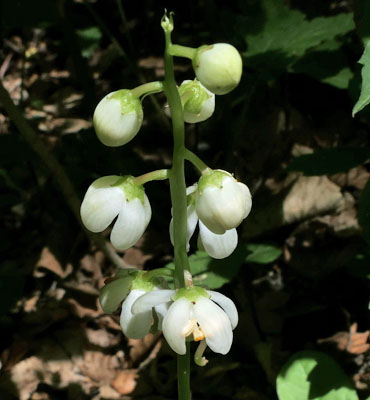
The Pyrola elliptica flower cluster forms an erect raceme with about 6 to 15 nodding flowers. A raceme is a unbranched stem with flowers attached to the stem with stalks which are called pedicels.
The flowers mature from the bottom up and frequently, there are flower buds on the top of the cluster and the lower flowers are beginning to fruit.

Individual flowers: What do the flowers really look like?
The nodding bell-shaped flowers are white to greenish white. The 5 petaled flower measures about a half inch across.
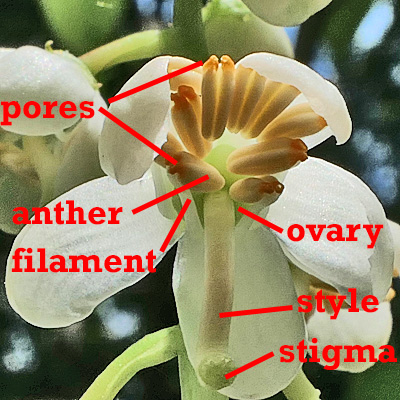 In the Pyrola elliptica flower, the long structure extending downward beyond the petals, like an elephabnt's trunk, is the elongated style with the greenish stigma at the end. Together with the ovary which is pale green and hard to see at the base, these form the female reproductive structure, the pistil.
In the Pyrola elliptica flower, the long structure extending downward beyond the petals, like an elephabnt's trunk, is the elongated style with the greenish stigma at the end. Together with the ovary which is pale green and hard to see at the base, these form the female reproductive structure, the pistil.
The male reproductive structure, the stamen, consists of a long filament with a anther on top. The anther has two chambers (2 thecae) which contain the pollen. At the end of each theca is a pore. The pores are located close to where the theca is attached to the filament. More photos of the pores are on the P. americana page
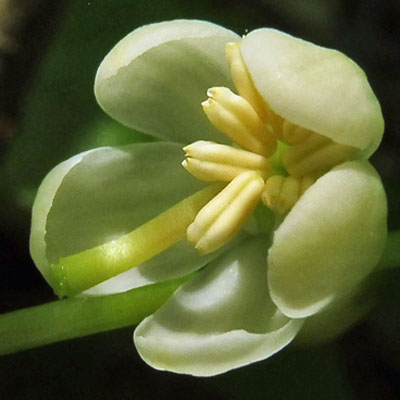
Here is a very fresh flower,
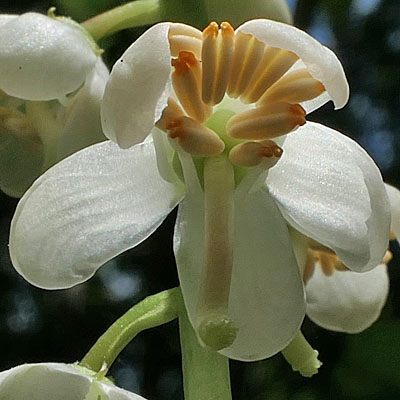 With the flowers facing downard, it is difficult to see under the petals especially since the flowers are also low to the ground.
With the flowers facing downard, it is difficult to see under the petals especially since the flowers are also low to the ground.
The 10 stamens bend and crowd under the petals of the outer side and the stigma extends downward. The ovary is green and globose and is hidden by all the stamens. Barely visible are 5 lobes on the stigma.
The pistil is actually composed of 5 fused carpels (pistils)
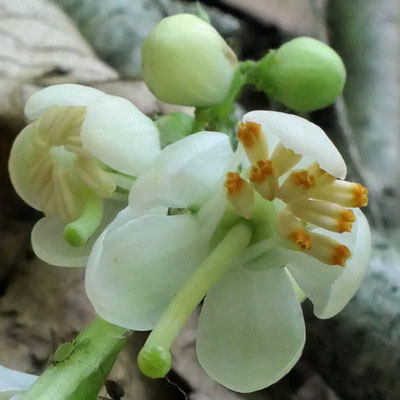
Pollination: In P. elliptica the pores open downward but to conserve pollen it is sticky and does not just fall out. The flowers offers no nectar reward to their pollinators. However, pollen is very nutrient/protein rich, energetically expensive for the plant to make, and is highly desired by insects. The pollen is the reward for 'buzz pollinators'. Buzz pollinators are mainly bees, e.g. bumble bee. Not all bees are buzz pollinators. Buzz pollinators use vibrations to extract pollen from flowers and incidentally pollinating them when they go from flower to flower. Later the bee grooms the remaining pollen from its body into pollen-carrying structures and transports the pollen back to the nest.
During buzz pollination, bees use their thoracic (flight) muscles to produce vibrations which cause pollen to be shaken up inside the anthers and then to be forcefully propelled outside the anther and onto the bee's body. The bee creates vibrations of up to 400 Hz, or 24,000 vibrations per minute, an audible middle-C buzz. The bee grasps the anther with its legs and vibrates its body. The flight muscles vibrate very rapidly without moving the wings. The bee lays its wings flat against its back and effectively uncouples the wings from the flight muscles, so the body vibrates instead. This vibration shakes electrostatically charged pollen out of the anthers, and the pollen is attracted to the bumblebee's oppositely charged body hairs.
Many genera including Pyrola, Vaccinium (blueberry etc), Solanum (nightshade), Gaylussacia (huckleberry) and Chimaphila (wintergreen), exhibit poricidal dehiscence, pollen released through pores. Buzz pollination is frequently associated with poricidal dehiscence. Many agriculturally important plants like potatoes, tomatoes, eggplants, peppers, pumpkins, zucchinis, blueberries and cranberries are buzz pollinated. It is estimated that about 58 percent of bee species can buzz pollinate.
Sepals - why a special section: Diagnostic characteristics include the sepals that are used to distinguish P. elliptica from P. americana and other pyrola.
The sepals are frequently refered to as calyx lobes or calyx bracts.
In Pyrola elliptica the sepals are as wide or wider than they are long. Also they are about 25% as long as the petals. The shape is more triangular. The sepals rapidly come to a longer sharp point.
However, sometimes the distinctions are not always clear. For comparisons see the >P. americana page

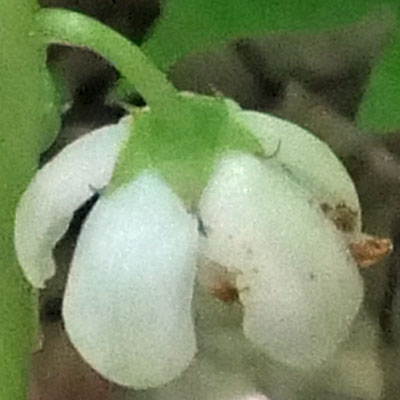
Fruit
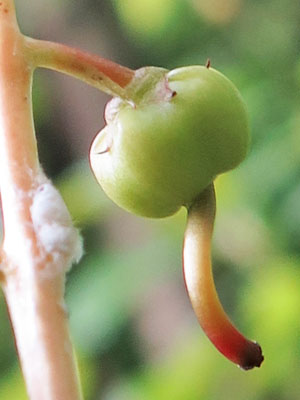
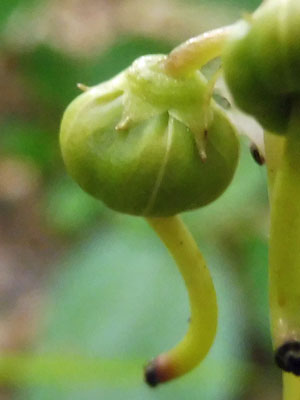 The flower is begining to fruit and the unneeded petals and stamens have been dropped. The globular ovary, developing fruit, is conspicuous. Also seen are the shape of the sepals - triangular, short, wider than long.
The flower is begining to fruit and the unneeded petals and stamens have been dropped. The globular ovary, developing fruit, is conspicuous. Also seen are the shape of the sepals - triangular, short, wider than long.
Numerous tiny seeds with wings are produced and they are wind dispersed.
Leaves
The leaves are basal and evergreen so you can see them even in the winter. Recognizing the leaves is a big step in distinguishing P. elliptica from P. americana. Frequently only the leaves are available to look at. The leaves are up to about 3 inch long and depending on their shape about 2.25 inches wide.
The leaves are thin. Beyond the slight puckering between the veins, the leaves are not flat. The waviness of the leaves are pointed at by the yellow lines in the first photo and can be seen in the other photos. The shapes of the leaves are a bit variable from oblong (rectangle like with rounded ends) to elliptic to round. Note also the small teeth along the margins and parts of the margins are some times scalloped. However, sometimes the distinctions are not always clear.
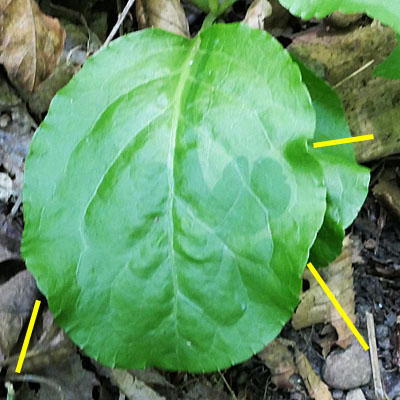
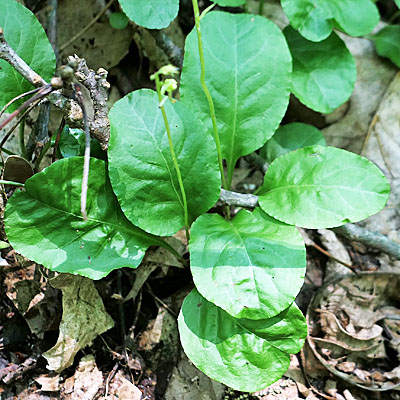

Plant
The plant is up to about 12 inches tall.

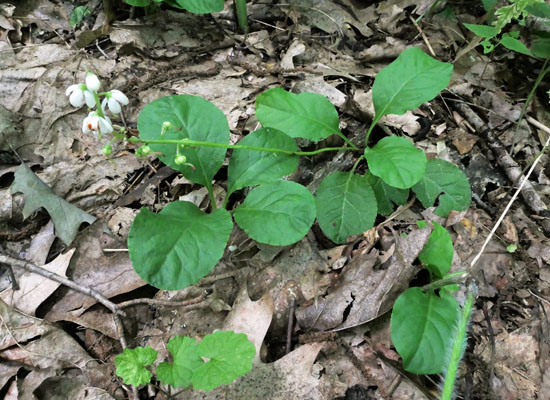
Above the flower stalk has fallen over
Habitat
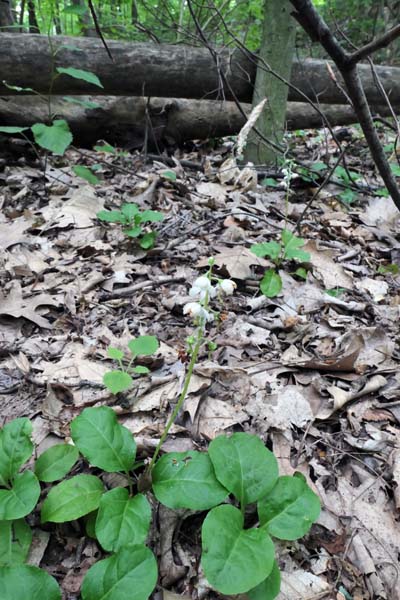 Habitat: Pyrola elliptica grows in the shadow of the trees in the forest.
Habitat: Pyrola elliptica grows in the shadow of the trees in the forest.
Research has shown that pyrolas are a mixotroph at least as a seedling underground. Mixotroph means that the plant can use a mix of different sources for energy and carbon.
The seeds are tiny and are referred to as 'dust seeds' and do not have any food storage for the seeds to develop. The seeds depend on mycorrhizal fungal relationships to obtain carbon. The seedling remains underground for a significant duration and relys on the fungal relationship to grow. This is termed as full myco-heterotrophy.
However, I have not found research on Pyrola elliptica to indicate it is a mixotroph as an adult. In the adult stage, some of the green species of pyrola that were studies are not partial myco-heterotrophs and some are. Much work is being done to identify the fungi and their type of relationships and the amount of C, N and H being transfered between the fungi and the myco-heterotrophs. For a discussion see the P. americana page
Text by Millie Ling and all photos by Hubert & Millie Ling: Photos of flowers were taken in mid-summer in preserves in NJ.
Additional information
Additional information / references:
The USDA website shows its distribution in the US which is mainly north east and gives the various synonyms:
https://plants.sc.egov.usda.gov/home/plantProfile?symbol=PYEL
Keys to the pyrolas that are present in NJ:
http://floranorthamerica.org/Pyrola
https://gobotany.nativeplanttrust.org/dkey/pyrola/#all
https://michiganflora.net/genus.aspx?id=pyrola
Buzz pollination:
https://www.irishexaminer.com/lifestyle/healthandwellbeing/arid-40047884.html
Video of buzz pollination
https://www.youtube.com/watch?v=J7q9Kn1rhRc
Pyrola elliptica : Detailed description
http://www.efloras.org